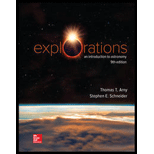
Concept explainers
The radii of Rigel and Barnard’s star compared to a solar radius using the Stefan-Boltzmann equation and show that the values agree with the radii in figure 13.23.
Answer to Problem 15P
The radii of Rigel is
Explanation of Solution
The luminosity of the Rigel star is
The luminosity of the Barnard’s star is
Write the Stefan-Boltzmann equation
Here,
Rearrange equation (I) to solve for
Divide
Substitute
Substitute
The radii indicated by the diagonal lines in figure 13.23 show that
Conclusion:
Thus, the radii of Rigel is
Want to see more full solutions like this?
Chapter 13 Solutions
Loose Leaf For Explorations: Introduction To Astronomy
- Why do you think astronomers have suggested three different spectral types (L, T, and Y) for the brown dwarfs instead of M? Why was one not enough?arrow_forwardIf the Sun were replaced by a white dwarf with a surface temperature of 10,000 K and a radius equal to Earth’s, how would its luminosity compare to that of the Sun?arrow_forwardWhat are the largest- and smallest-known values of the mass, luminosity, surface temperature, and diameter of stars (roughly)?arrow_forward
- A G2 star has a luminosity 100 times that of the Sun. What kind of star is it? How does its radius compare with that of the Sun?arrow_forwardWhat is the defining difference between a brown dwarf and a true star?arrow_forwardThe apparent magnitude of a star is observed to vary between m = +0.4 and m = +0.1 because the star pulsates and hence continuously changes its radius and temperature. When at its peak brightness, the star’s radius has increased by a factor of two compared to its value at the mini- mum brightness. Determine the value of T+/T−, where T+ is the temperature when the star is at its peak brightness and T− is the temperature when the star is at it minimum brightness. Note: we expect T+/T− < 1 because the star’s temperature decreases as its radius increases.arrow_forward
- The mass-luminosity relation describes the mathematical relationship between luminosity and mass for main sequence stars. It describes how a star with a mass of 4 M⊙ would have a luminosity of ______ L⊙. If a star has a radius 1/2 that of the Sun and a temperature 4 that of the Sun, how many times higher is the star's luminosity than that of the Sun? (If it is smaller by a factor of 8, you would write 0.125 because 1/8=0.125) If a star has a radius 2 times larger than the Sun's and a luminosity 1/4th that of the Sun, how many times higher is the star's temperature than that of the Sun? (If it is smaller by a factor of 8, you would write 0.125 because 1/8=0.125) If a star has a surface temperature 2 times lower than the Sun's and a luminosity the same as the Sun, how many times larger is the star than the Sun? (If it is smaller by a factor of 8, you would write 0.125 because 1/8=0.125)arrow_forwardA star has a period of P = 37 days. It has a radius of 5.7 times the radius of the sun. Calculate it's equatorial speed Vrot. Answer: Okm/s Om/s Check A star has a radius of 5.7 times the radius of the sun and a mass of 18 times the mass of the sun. It rotates at 0.7 of the critical speed W, the speed at which it's surface at the equator is actually in orbit. Recall Vrot is calculated at the equator and W= Vrot/Vorb Calculate it's period P. Answer: Odays Ohours Oseconds Checkarrow_forward
 Stars and Galaxies (MindTap Course List)PhysicsISBN:9781337399944Author:Michael A. SeedsPublisher:Cengage Learning
Stars and Galaxies (MindTap Course List)PhysicsISBN:9781337399944Author:Michael A. SeedsPublisher:Cengage Learning Foundations of Astronomy (MindTap Course List)PhysicsISBN:9781337399920Author:Michael A. Seeds, Dana BackmanPublisher:Cengage Learning
Foundations of Astronomy (MindTap Course List)PhysicsISBN:9781337399920Author:Michael A. Seeds, Dana BackmanPublisher:Cengage Learning Stars and GalaxiesPhysicsISBN:9781305120785Author:Michael A. Seeds, Dana BackmanPublisher:Cengage Learning
Stars and GalaxiesPhysicsISBN:9781305120785Author:Michael A. Seeds, Dana BackmanPublisher:Cengage Learning AstronomyPhysicsISBN:9781938168284Author:Andrew Fraknoi; David Morrison; Sidney C. WolffPublisher:OpenStax
AstronomyPhysicsISBN:9781938168284Author:Andrew Fraknoi; David Morrison; Sidney C. WolffPublisher:OpenStax



